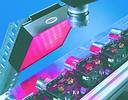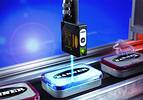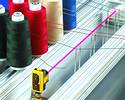
Banner Engineering is offering PresencePLUS Pro, a new camera-based visual inspection sensor for a price that is somewhat less than would be expected. This unique new sensor transforms costly, complex machine vision systems into a simple, easy-to-use and affordable sensor. Like larger, more complex and expensive systems, PresencePLUS Pro captures images and analyses them using one or more vision tools to generate judgement results. "Its video output, Teach Tool, and significantly lower price tag are its biggest strengths," said Alan Carr, body shop engineer, North American Car Group, General Motors Corporation.

Simple, straightforward programming makes the PresencePLUS Pro easy to install and operate. "Establishing the optimum focus, lighting, and other photographic parameters of an inspection was well facilitated with the aid of the video output from the Banner controller. Adjusting the target image on a TV monitor is actually much easier than using a laptop display due to the high resolution and refresh rate," Carr also said. Even with minimal knowledge of vision systems, an inspection that correctly tests and rejects bad parts on a production line can be quickly set up. The system is set up using a remote PC, and after set up, inspections are stored in the system without the need for the PC. The system performs multiple inspections simultaneously and inspects for both translational and rotational variation. Parts moving down a production line or web are accurately inspected without the need to be orientated in exactly the same way in the camera's field of view.
PresencePLUS Pro offers point-and click automatic 'TEACH' or custom set-up. An inspection is set up by simply illuminating the target, focusing the camera and selecting the appropriate analysis tools. The full range of inspection tolerances can be set up automatically or manually.
According to Carr, "One of the most beneficial, yet simple advantages of the Banner sensor was its TEACH Tool. This tool was extremely valuable for eliminating guesswork and applying the statistical variation of a sample to a tool's acceptable operating limits." Banner's unique TEACH system is a self-setting system with easy-to-use programming for basic and advanced inspections. New users can follow the guided set-up sequence, while advanced users can override automatic settings and create highly customised inspections.
PresencePLUS Pro offers both Ethernet and flexible I/O in the same full-featured sensor. Communicating both over the Ethernet or standard serial protocols, the sensor's removable terminal block accommodates configurable inputs (NPN/PNP), configurable outputs (NPN/PNP) and allows stored inspections to be selected. In addition, PresencePLUS Pro offers the ability to communicate data, measurements, and information for system process control over the Ethernet via TCP/IP and/or serially with an ASCII string. This communication function provides the user with measurement and system monitoring capabilities.
PresencePLUS Pro inspection tools include two locational tools: one is the 'Locate' tool which determines translation and rotation by detecting relative movement of edges; the 'Pattern Find' tool determines translation and rotation by detecting relative movement of a pattern. Five categories of vision tools are also included. These tools perform the 'image analysis' function including; a 'Grey Scale' tool which determines the average grey scale value, a 'Blob' tool which determines the presence, connectivity, and location of selected features, an 'Edge' tool which determines the presence, number, classification, and location of edges, an 'Object' tool which determines the presence, number, classification, size, and location of objects, and a 'Pattern Count' tool which determines the presence, number, and location of a pattern(s).
Two additional analysis tools measure or evaluate the results of the vision tools. A 'Measure' tool, measures the distance between two prescribed points. These points can be either edges or centroid locations; a 'Test' tool evaluates results of selected vision and analysis tools to determine whether an inspection passes or fails. It also performs logical operations and activates outputs.
Banner Engineering is a world-leading manufacturer of precision measurement systems, photoelectric and ultrasonic sensors, fibre-optic assemblies, and electronic machine guarding systems.
Sensors that cannot be fooled by colour and contrast shifts
The new QL Series of microprocessor-controlled luminescence sensors (QL50 and QL55). These self-contained sensors use a modulated ultraviolet LED to scan for luminescence in materials and are not affected by colour or contrast shifts that can challenge traditional optical sensors. The QL Series sensors detect luminescence that is inherent in a material or it can sense luminophores that have been added to a material in process to make it luminescent. "Luminescence sensors are ideal for applications requiring the detection of colour marks, clear adhesive labels, tamper-evident seals, oil or grease and fluorescent product markings where the background colour may vary causing a contrast change that would confuse or fool other sensing methods," said Joe Dolinsky, technical manager of Banner's photoelectric products. "Our new QL50 and QL55 offer an effective sensing solution for these applications that are too challenging for conventional photoelectric sensors. Their powerful microprocessor design provides accurate sensing at the high speeds found in automated production and they can differentiate luminescent marks on reflective surfaces such as ceramics, metal and mirrored glass," Dolinsky added.

Both models feature simple pushbutton programming. The QL50 may be programmed two ways. A Quick-SET mode where the sensor is taught to detect the specific luminescence intensity of a target and ignore the less-intense background, and a Fine-Detect mode that increases the unit's sensing precision to detect the specific luminescence intensity of a target and ignore all other surfaces with more or less luminescence.
The QL55 features a robust metal housing, enhanced sensitivity and two-step TEACH programming where the sensor is taught both the luminescent target and background conditions and automatically selects light operate or dark operate.
Both models feature a fast 250 ?s response time and two bright LEDs to indicate operating and outputs status. The QL50 has an active sensing range of 0 to 40 mm with maximum signal at 10 mm. The QL55 features sensing ranges from 9 to 75 mm depending on model. A compact housing size and 3-position rotating quick-disconnect cable add to the mounting flexibility of these sensors.
The QL50 offers NPN or PNP discrete outputs by model. The QL55 features switch-selectable NPN and PNP discrete outputs plus a 0 to 5,5 V d.c. analog output and an output off-delay option that extends the duration of the sensor's output by 20 ms.
New laser sensors feature extraordinary range and small object detection
The new World-Beam QS30 Series retro-reflective laser sensors, complement the diffuse units in this range. The LLP models feature a small, tightly collimated laser sensing beam diameter of 4 mm or less, allowing for precise sensing at ranges up to 18 m. The LLPC models offer superior small object detection where the target can actually be smaller than the sensing beam itself. Diffuse units offer a range of 400 or 700 mm and detect directly off the object without using a retro-reflective target. The sensors feature a visible Class 1 laser (class II for the long range diffuse model) and superb optical performance for the highest sensing power and accuracy, two discrete outputs, and an easy-to-read 8-segment LED bar graph display for status during set-up and operation.

"While the LLP and LLPC retro-reflective models share many of the same physical and component characteristics, they represent two totally unique sensing techniques - each with a very specific function," said Joe Dolinsky, technical manager for Banner's photoelectric products.
"The LLP, with its tightly focused laser spot and maximum excess gain feature, provides a powerful, precise long-range sensing solution that is not easily fooled by diffuse or shiny objects and operates with exceptional reliability even in dirty environments. It is ideal for long-range precise object detection such as box alignment on a conveyor, or over height detection. The LLPC features excellent low-contrast fine sensing capabilities for reliable detection in traditionally challenging sensing applications involving small or clear objects. It is ideal for detection of wafers and LCD glass, or thread and wire breaks on knitting machines," Dolinsky added.
Set-up is fast and easy for both sensor models with pushbutton programming and an advanced microprocessor design. Both units may be manually SET using the integrated pushbuttons or via a remote cable that can also be used to disable the pushbuttons to prevent undesired tampering.
The 10 to 30 V d.c. World-Beam QS30 sensors have a maximum output rating of 150 mA for each of their outputs. The outputs can be set for light operate (N.C.) or dark operate (N.O.), and feature a bipolar configuration with one NPN (current sinking) and one PNP (current sourcing) output. All units feature a tough ABS/polycarbonate blend housing that meets IEC IP67 standards and operates in temperatures of -10 to +50°C. The sensors are available with a 2 m PVC cable, 9 m PVC cable or 5-pin integral Euro-style quick-disconnect cable.
| Tel: | +27 11 453 2468 |
| Email: | [email protected] |
| www: | www.turckbanner.co.za |
| Articles: | More information and articles about Turck Banner Southern Africa |

© Technews Publishing (Pty) Ltd | All Rights Reserved